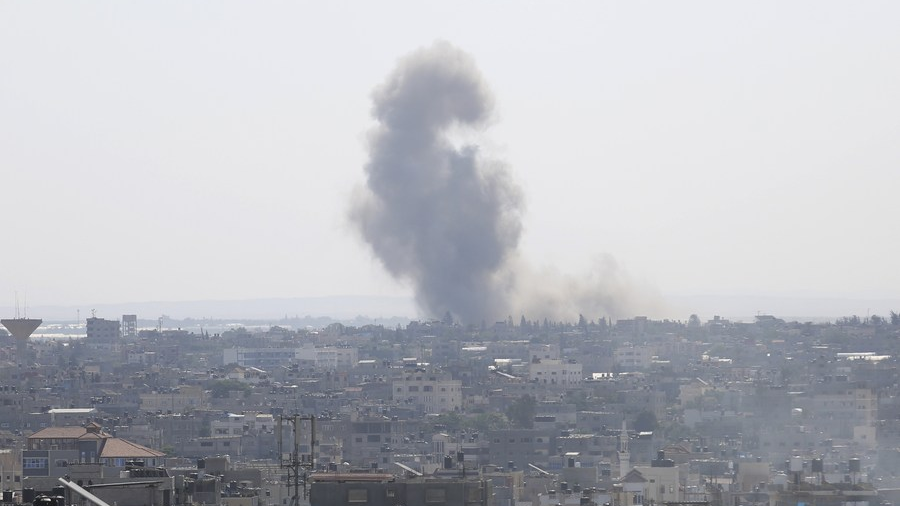
Smoke rising following an Israeli airstrike in the southern Gaza Strip city of Rafah, October 15, 2023. [Photo/Xinhua]
By Hussain Nadim
Since all wars have political ends, all wars are really about winning narratives. Now here is more at display than in the current Israel-Palestine conflict where the surprise ground attack by Hamas was closely coordinated with the narrative warfare conducted over social media. The live studio-like production quality of the attack demonstrates a new reality in warfare: Who wins the digital space, and more importantly, who wins the narrative?
I analyzed over 467,000 tweets using a custom-built digital analytics platform on different keywords and hashtags associated with the Israel-Palestine conflict. The data generates startling insights into the narrative warfare, the actors involved, and more importantly, the subtle geopolitical groupings and posturing that have emerged in the world. I narrowed down the search to four specific hashtags – #PalestineUnderAttack, #GazaUnderAttack, #IsraelUnderAttack, and #IStandWithIsrael – to study the digital behavior and narratives around the conflict that provide three deep insights.
The first insight is on the battle to dominate the digital space. The Palestinians dominated the digital space in the early hours of the attack as it took time for Israel to respond. This is partially because Israel was caught off guard and was more busy defending the ground attack and recovering from the shock than handling the information and digital warfare. This, however, started shifting as Western media, political actors, academics and activists around the world took a firm stand in support of Israel and we saw the numbers shifting. The repeated framing of the conflict as a "terrorist attack" and Hamas as a "terrorist organization" significantly reduced the space for neutral actors and pro-Palestine actors in the digital space to passionately throw support for Palestine. By the third day, Israel and Palestine both had an equal weightage on the digital space playing out mostly in two separate echo chambers as is visible through the data on the two hashtags #IsraelUnderAttack and #GazaUnderAttack. This is in stark contrast to the earlier conflicts between the two countries where overwhelmingly the digital space was dominated by the pro-Palestinian sentiment. The space, however, flipped once more in favor of Palestine as Israel continued with its airstrikes. At the moment based on the above two hashtags, Palestine has three times the volume of digital space compared to Israel.
The second important insight is on the emerging narrative clusters on the ongoing war. I used large language models (LLM) to analyze the social media data on the aforementioned hashtags to identify, map, and categorize different narratives while also tracking their trajectory over the seven days. Having studied digital warfare for the last eight years, one thing unique about this conflict is that the narratives moved faster than the human ability to analyze them. Therefore, assistance from an AI-powered platform was quintessential. The narrative fluctuated from the victory of Palestine and oppressed people taking the land back, to Israel being a victim of terrorism and international solidarity with Israel, back to criticism of Israel for bombing Gaza indiscriminately.

People remove the body of a victim from a building destroyed in Israeli airstrikes in the southern Gaza Strip city of Rafah, October 15, 2023. [Photo/Xinhua]
Six key narrative clusters emerged out of this conflict. At the meta-narrative level, there is a political cluster under which there is a tussle to frame the conflict as a terrorist attack vs. the push to present the attack as Palestinian liberation against oppression through a post-colonial lens. The second narrative cluster is a humanitarian one where the tussle primarily is to claim a monopoly on victimhood. Under this cluster, the sub-narratives range from innocent Israelis being killed by Hamas to innocent Palestinians in Gaza bombed by Israel. A prominent theme this time around in the humanitarian cluster is the suffering of babies in the war, which has intensified the narrative space.
The third is a revenge cluster under which the trickle-down narrative continues to polarize and dehumanize the "other" through narratives like "finish them" against Palestinians to "gas the Jews" against Israelis. The fourth cluster is the geopolitical one where the Israel-Palestine conflict is being discussed as part of the larger geopolitical rivalry between great powers. Attempts are being made, for instance, to link Iran or Russia on one end of the spectrum and the other end, there is a notion that U.S. and EU countries are adding fuel to the fire to keep the Middle East destabilized. There is also a"witch-hunt" cluster that is essentially monitoring and taking down anyone or any institution that does not fall in line with specific narratives. This is happening, for example, on one end against Harvard University student bodies that stated support of Palestine to public figures like Mehdi Hassan and Ilhan Omar that offered solidarity to the loss of civilian lives in Israel in the conflict.
Finally, there is a new and very large cluster that emerged on the third day which is the "fact check" cluster that is essentially fishing disinformation and fake news emerging from either side. Under this cluster, Israel is calling out Palestinian fake news of not targeting civilians while the Palestinians are calling out Israelis for their disinformation on Hamas beheading babies. These six clusters together form 90 percent of the digital conversation on the current war.
The third and last insight explores the networks and actors that are involved in shaping the narrative of the Israel-Palestine war. There is a clear grouping that has emerged since the war started. Much of the pro-Palestine conversation not only emerged from very specific Muslim countries including Pakistan, Yemen, Iran, Qatar, Malaysia, Turkey, and Syria but also from the public in major Western capitals like London, New York, Toronto, Sydney, and Berlin where the Muslim diaspora and even Jewish communities came out in numbers physically and digitally in support of Palestine. Additionally, I noticed strong support from the Russian information networks for the Palestinian cause albeit not endorsing the Hamas attack openly. Chinese information networks, however, chose to be on the sidelines by remaining neutral on the crisis during its early stages, but later showing solidarity with the people of Gaza in the wake of the Israeli attack. The pro-Israeli sentiment was mostly from Western government actors, the Israeli public, and the Indian state-linked information network that showed its support of Israel.
Even the academia and analysts were deeply divided on the subject with some supporting the Palestinian cause while rejecting the actions of Hamas, and other academics that used the post-colonial lens to explain the actions of Hamas as a direct result of Israeli oppression, to many other academics that viewed the attacks on Israel as a terrorist attack without context or history.
The digital grouping that emerged in the current crisis indicates a wider shift in the geopolitical space with the Muslim world disgruntled and horrified by the Western support to Israel.
The social media data on the conflict essentially can show and predict the future with good reliability. At the moment, everything indicates a major shift in posturing and narratives that will increase the volatility of the geopolitical landscape. The next crisis is already on the horizon if the leaders don't act responsibly.
Hussain Nadim, a special commentator on current affairs for CGTN, is a Maurice R. Greenberg World Fellow at the Jackson School of Global Affairs, Yale University.

 中文
中文



